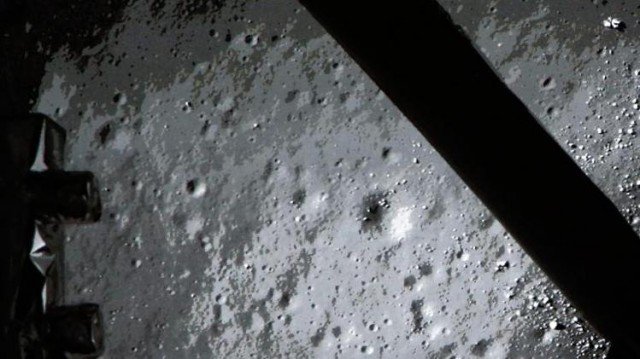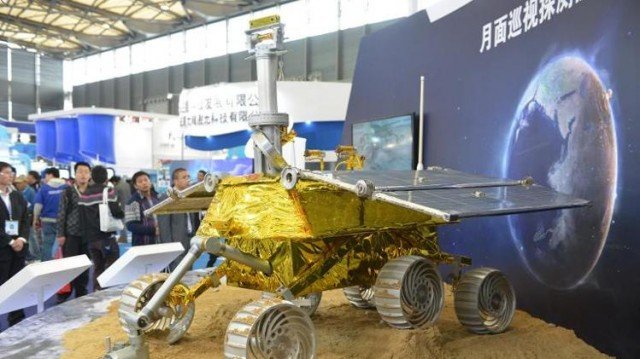Jade Rabbit lunar rover has been declared dead on the surface of the Moon, Chinese state media have reported.
The robot suffered a serious mechanical problem last month; officials have said it “could not be restored to full function”.

Jade Rabbit lunar rover has been declared dead on the surface of the Moon
The Jade Rabbit, or Yutu in Chinese, was deployed on the Moon’s surface on December 15.
It was the first successful soft landing on the Moon since 1976.
[youtube vQO6oyc95Os 650]
Chinese rover Jade Rabbit has driven off its landing module and on to the Moon’s surface.
The robotic vehicle rolled down a ramp lowered by the lander and on to the volcanic plain known as Sinus Iridum.
Earlier on Saturday, the landing module containing the rover fired its thrusters to perform the first soft landing on the Moon since 1976.
The touchdown in the Moon’s northern hemisphere marks the latest step in China’s ambitious space programme.
The lander will operate there for a year, while the rover is expected to work for some three months.

Jade Rabbit’s touchdown in the Moon’s northern hemisphere marks the latest step in China’s ambitious space programme
The Chang’e-3 mission landed some 12 days after being launched atop a Chinese-developed Long March 3B rocket from Xichang in the country’s south.
Xinhua news agency reported that the craft began its descent just after 21:00 Beijing time, touching down in Sinus Iridum (the Bay of Rainbows) 11 minutes later.
Chang’e-3 is the third unmanned rover mission to touch down on the lunar surface, and the first to go there in more than 40 years. The last was an 1,900lb Soviet vehicle known as Lunokhod-2, which was kept warm by polonium-210.
But the six-wheeled Chinese vehicle carries a more sophisticated payload, including ground-penetrating radar which will gather measurements of the lunar soil and crust.
The 260 lb Jade Rabbit rover can reportedly climb slopes of up to 30 degrees and travel at 660ft per hour.
[youtube 3sS9GqnDYAU 650]
China has launched its first lunar rover mission to space.
The Chang’e-3 mission blasted off from Xichang in the south at 01:30 Monday local time (17:30 GMT Sunday).
The Long March rocket’s payload includes a landing module and a six-wheeled robotic rover Yutu (Jade Rabbit).
The mission should land in the Moon’s northern hemisphere in mid-December.
Chinese state TV carried live pictures of the launch of the Chinese-developed Long March 3B rocket carrying the lunar probe.
This will be the third robotic rover mission to land on the lunar surface, but the Chinese vehicle carries a more sophisticated payload, including ground-penetrating radar which will gather measurements of the lunar soil and crust.

The 260lb Jade Rabbit rover can climb slopes of up to 30 degrees and travel at 660ft per hour
The 260lb Jade Rabbit rover can climb slopes of up to 30 degrees and travel at 660ft per hour, according to its designer the Shanghai Aerospace Systems Engineering Research Institute.
Its name – chosen in an online poll of 3.4 million voters – derives from an ancient Chinese myth about a rabbit living on the moon as the pet of the lunar goddess Chang’e.
The lander’s target is Sinus Iridum (Latin for Bay of Rainbows) a flat volcanic plain thought to be relatively clear of large rocks. It is part of a larger feature known as Mare Imbrium that forms the right eye of the “Man in the Moon”.
Other details of the mission are sketchy; the rover and lander are powered by solar panels but other sources suggest they also carry radioisotope heating units (RHUs) containing plutonium-238 to keep them warm during the cold lunar night.
Chang’e 3 is “the most complicated and difficult task yet in China’s exploration of space” and incorporates lots of new technology, Xinhua reported Wu Zhijian, a spokesman with the State Administration of Science, Technology and Industry for National Defense, as saying.
The launch comes at a time when the Asian superpower is asserting itself in other areas, such as control of airspace over the East China Sea. China considers its space programme a symbol of its rising global stature and technological advancement, as well as of the Communist Party’s success in reversing the fortunes of the once impoverished nation.
[youtube 24ckLeUlr3o 650]



